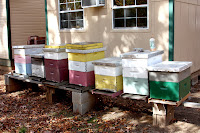Daylily Kindly Light

Daylilies or Hemerocallis come in so many heights, colors, and flower forms that only a public garden could have a significant number of them in a collection. Even though yellow is not a flower color I aspire to have more of in our garden, this Kindly Light Daylily is one that is so lovely, it is hard to resist. Old House Gardens catalog describes it as "decidedly different" and the first spider Daylily. The roots are $7.50 each at http://www.oldhousegardens.com/display.aspx?cat=daylily&page=2 Daylily Diary has a gorgeous photo at http://daylilydiary.com/day_kindlylight.htm The American Hemerocallis Society's website says it blooms mid-season and grows to 2.5 feet tall. Click over to their site at http://www.daylilies.org to learn more about these wonderful plants. If you click on search all, you arrive at a link with 76,000 daylilies to browse. You will find that Daylilies can become the backbone of a flower garden because they are so eas...









.JPG)